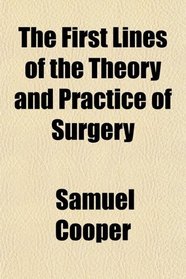Search -
The First Lines of the Theory and Practice of Surgery
The First Lines of the Theory and Practice of Surgery
Author:
Purchase of this book includes free trial access to www.million-books.com where you can read more than a million books for free. This is an OCR edition with typos. Excerpt from book: eoing, a loosened state of their textures, more particularly in the situation where the pus is first produced, or about the centre of the inflammation. Perhaps a... more »
Author:
Purchase of this book includes free trial access to www.million-books.com where you can read more than a million books for free. This is an OCR edition with typos. Excerpt from book: eoing, a loosened state of their textures, more particularly in the situation where the pus is first produced, or about the centre of the inflammation. Perhaps a... more »
ISBN-13: 9780217757652
ISBN-10: 0217757650
Publication Date: 8/17/2009
Pages: 382
Rating: ?
ISBN-10: 0217757650
Publication Date: 8/17/2009
Pages: 382
Rating: ?
0 stars, based on 0 rating
Genres:




